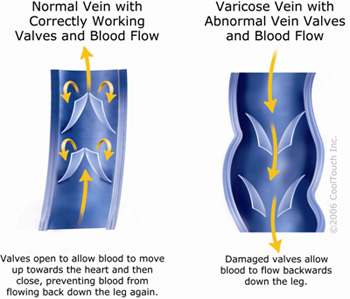|
Deep Veins
These are by far the most important veins. They normally drain 90% of blood flow from the legs and can readily assume the function of superficial veins. These veins are called deep because they located between muscle compartments deep in the legs. The two main deep leg veins are the femoral and popliteal veins.
Superficial Veins
These veins collect blood from the skin and structures immediately below and direct it into the deep veins. The major superficial vein is the great saphenous vein which collects blood from the skin over the inside of the leg from the ankle up to the thigh. At the groin the great saphenous vein drains into the femoral vein. The small saphenous vein drains blood from the outer ankle up the calf to the back of the knee. Behind the knee the small saphenous vein drains into the popliteal vein. The skin over the remaining area of the leg above and below the outside of the knee is drained by a much smaller system of veins that is often referred to as the lateral (Albanese) venous system.
Perforator Veins
Perforator veins are numerous and normally very small direct connections between the superficial and deep veins. They direct blood from the skin surface down into the deep veins, are an important component of the muscle pump, and represent an alternate pathway for blood drainage if the saphenous veins are blocked or removed.
Normal Mechanism of Venous Blood Flow in the Legs
Leg muscles, especially those of the calf, are often described as the second heart. They play a crucial role in emptying blood from leg veins when we stand or sit. Because these muscles surround the deep veins, when they contract they squeeze and empty them. A series of one way valves inside each deep vein ensures that the squeezed blood only flows up towards the heart. Relaxation of these muscles siphons blood from the superficial saphenous veins into the emptied deep veins via perforator veins. One-way valves in perforator veins again normally ensure venous blood flow from superficial to deep veins. The muscle pump therefore also normally drains superficial (saphenous) veins via perforator veins.
Venous Insufficiency
Venous insufficiency is present when leg veins are no longer able to efficiently carry blood back to the heart. This may be the result of blockage (obstruction), valve leakage, or both. The increase in vein pressure produces chronic inflammation, impaired tissue perfusion, ankle swelling and often debilitating symptoms.
The most common mechanism of chronic venous insufficiency is valve incompetence. The vein valves in the legs can be overstretched by obstruction upstream, damaged by inflammation, or become distorted by dilation and tortuosity of the vein wall. Weakness of the vein wall is commonly inherited and to some extent may be part of normal aging. Regardless of the cause, damaged or deformed valves do not close completely and allow backward flow of blood (venous reflux).
Venous Reflux
Backward flow in leg veins may occur in superficial, perforator or deep veins. It most commonly affects the saphenous veins and their tributaries. Venous reflux in perforator veins is also relatively common. Reflux is least common in deep veins.
When reflux is only mild, blood flow is still mostly in the normal direction upward towards the heart and backward flow (reflux) is significant only with prolonged standing or sitting. Severe insufficiency is present when the amount of backward flow equals or exceeds forward flow. The severity of backward flow can only be accurately assessed with ultrasound examination and in the standing position. Severe reflux is typically associated with symptoms or complications such as skin damage or vein rupture. With time the abnormally high vein pressure interferes with blood flow to the skin causing swelling, discoloration, inflammation, poor healing and even ulceration. The chronic inflammation often produces irreversible skin damage. In order to treat this problem, veins with defective valves must be eliminated from the circulation allowing unaffected veins to take over and restore normal physiology.

|